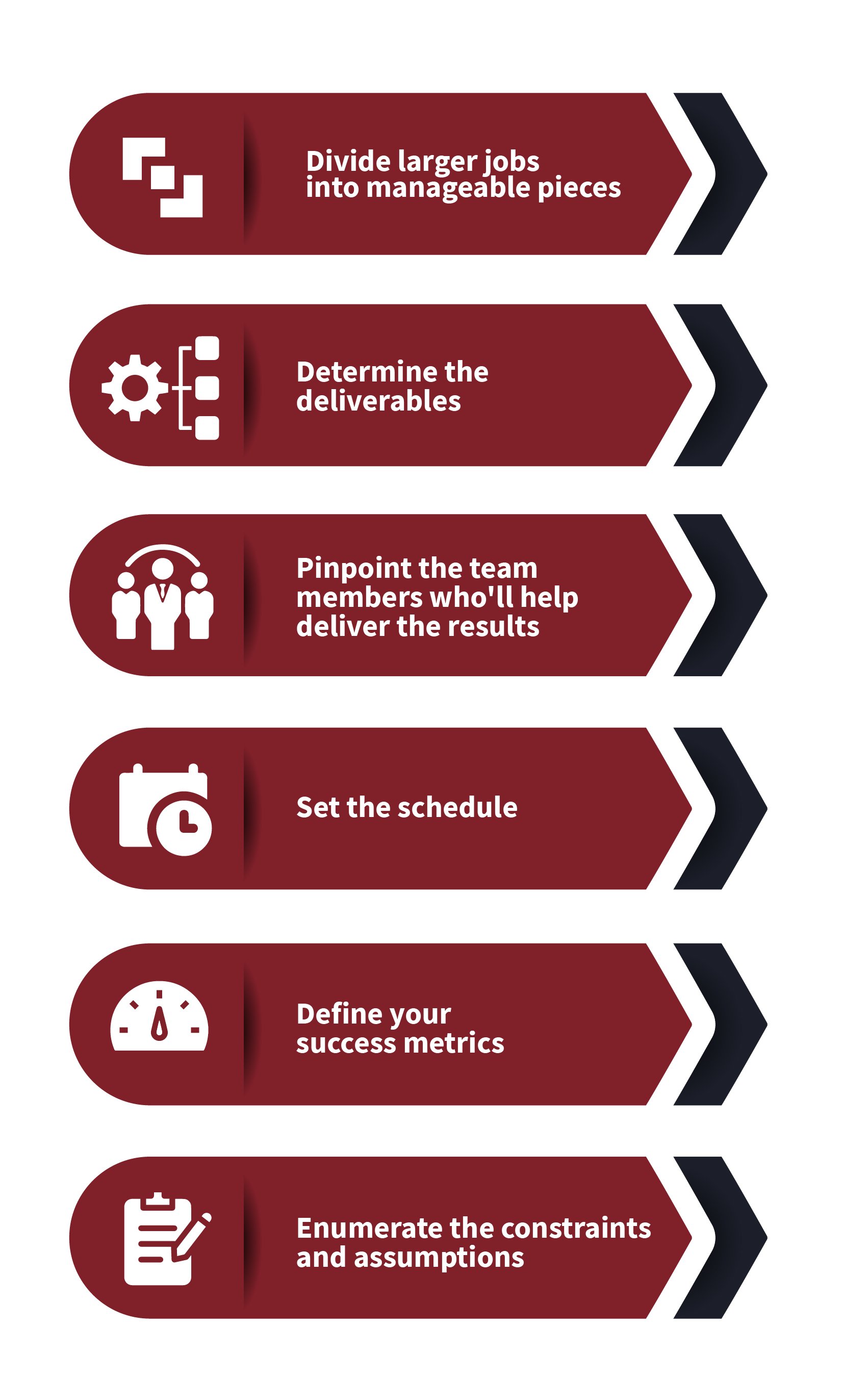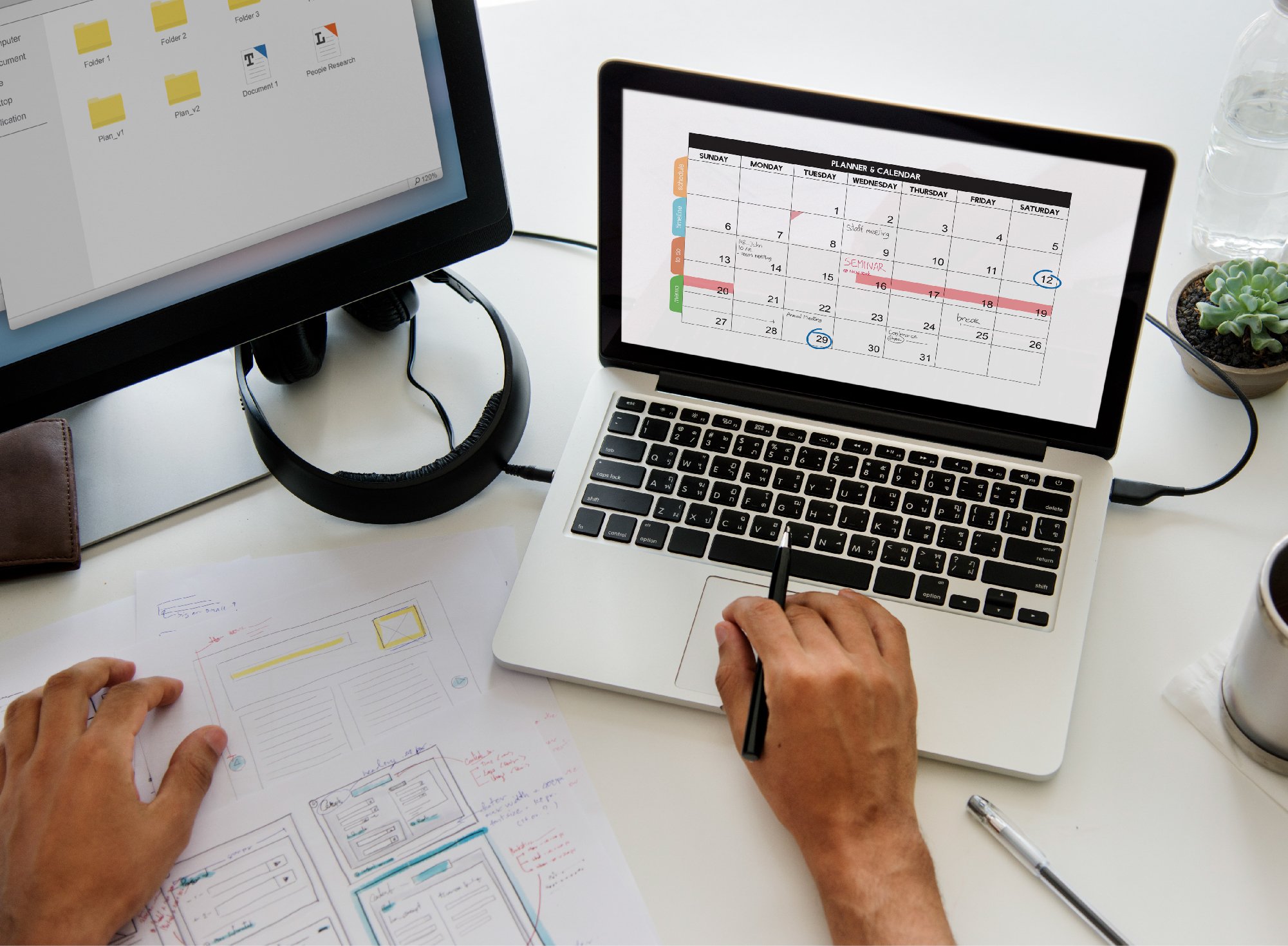Being given the reins of a project is just the start. You'll need to devise a strategy to drive it to success, but simply copy-pasting the specifications you received won't cut it. Creating a project management plan is the best way to ensure your efforts meet demand as you execute, oversee, evaluate, and follow up on your project. Here's how to devise a plan that works and keeps you on track – in just seven steps.
What Is Project Planning?
Project management planning is the first step to completing any new undertaking. It involves the further refinement of the project's stated scope, goals, and metrics, resulting in simple outlines or other documents that give your stakeholders, team members, and organisational leadership deeper insights into how the work best ought to proceed. Project plans also make it easier to share your ongoing progress – by offering everyone a common-ground reference point to look back to for guidance.
Why Should You Invest in Project Planning?
Project planning breaks larger journeys down into more explicit steps and milestones. In the process, it grants you a benchmark for performance self-assessments.
Project management also promotes effective, efficient work in environments where talented professionals must simultaneously juggle more than one thing. With some 59 per cent of project managers running between 2 to 5 projects at once, intelligent oversight helps enterprises keep the threads from getting too tangled.
Above all else, transparent project planning heightens cost transparency: Setting an open tone from the smart makes it easier to get into the habit of sharing your financial results with others in your organisation. This keeps you honest and might even motivate you to push harder in a crunch.
Seven Steps for Project Planning Success

Project plans don't have to be complicated – taking a straightforward approach can help improve your plan's utility, particularly if you're just creating an outline-style document:
1. Redefine the Project's Boundaries

Most projects involve some scope or the extent of work they pertain to. They also include objectives, which let you know when you've accomplished the job.
Your project's scope and objectives may be practically nonexistent, or they might have come with the assignment. Either way, you should redefine these key factors on your terms, working to retain the essence while simultaneously breaking big ideas down.
- Divide larger jobs into manageable pieces: Split each task into the prerequisites and subtasks required to complete them. Also, make a note of the human and material resources you'll need to accomplish every item.
- Determine the deliverables: Deliverables include everything from drafts, proofs, prototypes, and samples to advertising content, consumer feedback data, and campaign results. Refer to your task lists, making sure they chart clear courses for producing all deliverables by the project deadline. It may also help to create recipe lists of resources for each deliverable.
- Pinpoint the team members who'll help deliver the results: Be sure to assign specific roles, including identifying team leadership responsible for keeping groups on task. If you're unsure about including an individual or role, make a note to let the team leader know they have some leeway when forming their squad.
- Set the schedule: Pick specific times for each of the milestones you'll meet along the way. This should include tentative dates for progress meetings and feedback sessions.
- Define your success metrics: Whether you're beholden to client approval, social media engagement stats, or some other rubric, you need a clear definition of what success looks like.
- Enumerate the constraints and assumptions: Are you up against a hard deadline or a budget? Do you have to wait for another project's completion before you can start working? Listing your constraints along with any assumptions makes it easier to see how these bounds define your capacity for achievement.
2. Organise Your Human Assets

Go back to the list of project team members you identified earlier. Your outline should include a section that expands on these assignments and roles – while identifying other stakeholders who might also play a part.
Project stakeholders aren't just the people on your production teams: They include everyone your project might impact, such as customers and end-users. Your marketing department staff, distribution partners, and customer service representatives are stakeholders.
This is the best juncture to identify these individuals or groups and consider how your plan ought to relate to them. For instance, if your project entailed designing a new product, you might solicit feedback from your warehousing staff on which package designs made the best use of storage space. A project that involved legally regulated processes, substances, or products might benefit from the inclusion of insights or opinions from a compliance officer.
Each project is different, but they all need to address stakeholder relationships. Business software that makes it easy to assign tasks and roles can help you get accustomed to working with distributed teams, resulting in more efficient oversight and heightened productivity.
3. Build a Timetable by Filtering Out the Milestones

By now, your project plan is probably looking somewhat fleshed out. This is the ideal time to start a new section dealing solely with the timetable.
Building a separate milestone section can highlight how the different pieces come together. You'll likely receive requests to share this information with leaders, budget analysts, and other stakeholders, so it's worth splitting it out into an independent document.
While you'll essentially be extracting schedule data from your previous milestones and deliverables definitions, it's OK to add new key dates as you construct the calendar. For instance, you'll probably want to keep a separate schedule for yourself to follow as the project manager.
4. Analyse the Risks
Risk management is critical to project damage control. Even if the tasks they involve don't seem too hazardous themselves, embarking on new projects might pose various organisational risks. For instance, focusing a significant chunk of your workforce on a specific task might leave you blind to events like market swings or sales opportunities. In some cases, such as software redesign projects, your chosen work methodology might be inherently hazardous – such as if you decided to start changing mission-critical business code on a live system!
Other risks are more mundane. It's common for projects to represent budget gambles that might prove impossible to recoup in the event of failures. Public-facing projects might also risk incurring negative public opinion, potentially limiting future revenue.
How can you get a handle on all of this? Risk analysis isn't about avoiding or eliminating all sources of peril. Instead, the goal is to define the different hazards as thoroughly as possible: The simple act of cultivating an awareness of what could go wrong increases your odds of recognising potential failures mid-stride and responding properly.
5. Establish Clear Communication Standards

How will you let project team members know when they meet expectations or need to pick up the pace? What form will your communications with investors or leadership stakeholders take, and when should you plan on holding these check-ins?
Defining how and when you'll communicate ahead of time is key to project planning success. In the face of the ever-present push to multitask effectively, people tend to compartmentalise how they work – It's vital to establish a baseline your team members can always refer to when they have questions or need collaborative help.
For minor projects, this step may be as simple as setting up a channel in a communication app. As jobs get more complex, however, it often proves advantageous to use a dedicated tool that keeps all of the data in one place, such as the assets that correspond to specific messages between teams and workers. Since the goal is effective oversight, dashboards and software tools that impose a sensible structure on communications and automatically save a convenient digital paper trail are ideal for retracing your steps and honestly gauging progress.
Also remember that if things can go wrong, they likely will. Maintaining consistent communication channels improves the speed and accuracy of information sharing when it's time to debug, troubleshoot, or reassess problems. Should you ever find yourself in a struggle for continued funding or project backing, these records might also demonstrate your ability to recover from missteps.
6. Plan the Project Kickoff

The kickoff meeting is one of the most important events in a project's lifecycle. It serves as your stakeholders' introduction to what's happening, how it's getting done, and why it's a worthy cause. It sets the tone for what you expect from your teams and assigns clear responsibilities so that everyone can start working from a common perspective.
Your project plan ought to include some brief notes regarding the kickoff, hinting at:
- How you'll summarise the primary project goal, key risks, and potential gains,
- What kinds of research or preliminary assets stakeholders ought to have prepared before attending the meeting,
- What level of detail you'll go into when sharing the major subtasks with their respective team owners,
- Whether you'll need to include a quick introduction or training session for a new communication tool, and
- What's the first common project milestone everyone ought to work towards?
These essentials are flexible: You'll also need to leave time for questions, introducing new team members, and other miscellaneous items. Just remember that a structured kickoff can make it easier to get moving.
7. Plan the Project Afterparty

Also known as a post-mortem, the project wrap-up involves getting everyone back together and evaluating how it all went. You'll assess things like:
- Whether you hit all of the milestones and how you might have avoided missing the ones you fell short on,
- Whether you stuck to the schedule and what caused any delays, and
- How your results measured up against the stated goals, like return on investment or marketing content engagement.
Looking back at what you did right and wrong is the best way to improve your managerial capacity and solicit valuable feedback from participants. It also offers lessons you can apply immediately, putting you on a better footing for your next project.
How Project Planning Software Is Vital to Effective Project Planning

Want to simplify your project planning strategy? Good project management software empowers you to define and oversee jobs from start to finish.
With project management applications, you gain an enhanced degree of transparency, as well as extra power to leverage any insights your new perspective reveals. Capable dashboards help you anticipate dynamic project lifecycle events by clarifying how past undertakings panned out and elucidating critical inputs. These benefits don't just apply to the planning stages either. Thanks to the power to streamline administrative tasks and generate rapid reports detailing the effects of your tweaks, overseeing a live project becomes far easier as well.
Communication should happen seamlessly; the tools used to keep messages, chats, and group sharing events flowing must operate in the background without getting in the way. Project management software facilitates effective communication within and among teams and centralises data storage, making it easier to keep the dialogue relevant and organised. Even better, project management systems can automate common communication tasks to minimise time spent disseminating information to relevant stakeholders. When something goes wrong, you ought to receive notifications, supporting documents, or reports no matter where you are, what time it is, or whether someone remembered to CC you into the message chain.
Effective tools also help you track key performance factors and generate instance progress reports as needed. Although managing a project is no small undertaking, many of the biggest challenges are surmountable with a capable, efficient project management tool – and it's a bonus if you can customise the system to match your unique productivity style.
The Tessaract Project Management Solution

Tessaract ticks all of these boxes to make project management more readily attainable. It automates tasks, letting you generate custom documentation, workflows, and jobs from project templates. It boosts organisation and transparency so that you always know exactly where you stand, syncing emails, files, and other assets in a native cloud system.
When it's time to assign work, Tessaract's task and role management dashboards make it effortless to delegate work properly without a complicated handover. The system even includes digital document signing, so getting approvals at critical milestones is no problem.
Project management doesn't have to be difficult, and if done right, it reduces your stress levels so you can focus on the task at hand. Try Tessaract to discover how taking a smarter approach could make your management style more productive.
